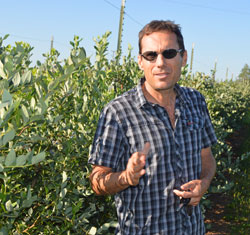Early Findings into New SWD Control Method Encouraging
An Oregon State University entomologist is arriving at some positive developments on research that could translate to significant savings for blueberry growers in their war against the spotted wing drosophila (SWD).
 |
OSU entomologist Vaughn Walton says preliminary results of research into an alternative method for controlling spotted wing drosophila are promising. |
At the 2020 Oregon Blueberry Conference, held in Salem in February, Vaughn Walton unveiled preliminary findings that showed placing tetradecanoic acid and other compounds in a slurry beneath blueberry bushes draws SWD to the slurry and away from berries, minimizing yield losses to the fly.
“We are finding a significant response,” Walton said. “We are finding that the majority of these flies sit on that medium and do not attack the berries.”
Walton added that the flies’ response to the compounds is unprecedented in his experience.
“In the 15 years I’ve been doing work in entomology, I have not seen this type of response,” he said. “I’ve worked on mating disruption with mealy bugs. I’ve worked on mating disruption of filbert worm – technologies that have been implemented in (other) industries. None of them have worked at this level at this stage.
“We found that this specific formulation works consistently under very high pressures for all of the susceptible fruit that we are working on,” he said.
Walton began pursuing the use of tetradecanoic acid as a control mechanism for the SWD after noticing flies deposit the volatile compound on scrapings it makes on berries when depositing eggs. He found that the compound subsequently attracts more flies.
“That is why in some scenarios, you can go from zero percent infestation to about ten percent infestation within a one-week period,” he said. “Because of those volatiles, you are getting massive increase in egg laying.”
He then devised a formulation to attract flies utilizing several compounds, including volatiles produced by the plant, volatiles produced by the insect and compounds to improve the texture of the resulting slurry. He and his team then created a delivery device that growers can place at the bottom of a bush at a rate of about 50 per acre.
“The idea is you are pulling these flies away from the fruit onto these dispensers,” he said.
Right from the start, in their initial experiments, the team found that flies would lay large quantities of eggs on the surface area of the slurry.
In further experiments, researchers found the attractant reduced crop damage by about 67 percent, a rate similar to pesticide treatments.
The compound remained effective for 21 days, he noted.
“There are still some limitations about this technology,” Walton said. “It is going to need some water on a daily basis to activate those volatiles, and you will need to place 50 of them per acre. However, when we compare this technology to conventional control methods, we know that this is a much cleaner technology and its efficacy is comparable to chemical controls.”
Walton said he hopes the technology is commercialized by this summer, noting companies are talking to OSU about adopting it.
“For in-season use, I think this has a lot of promise,” he said. “One could be eliminating one to two, maybe even three pesticide sprays if you are using this.”